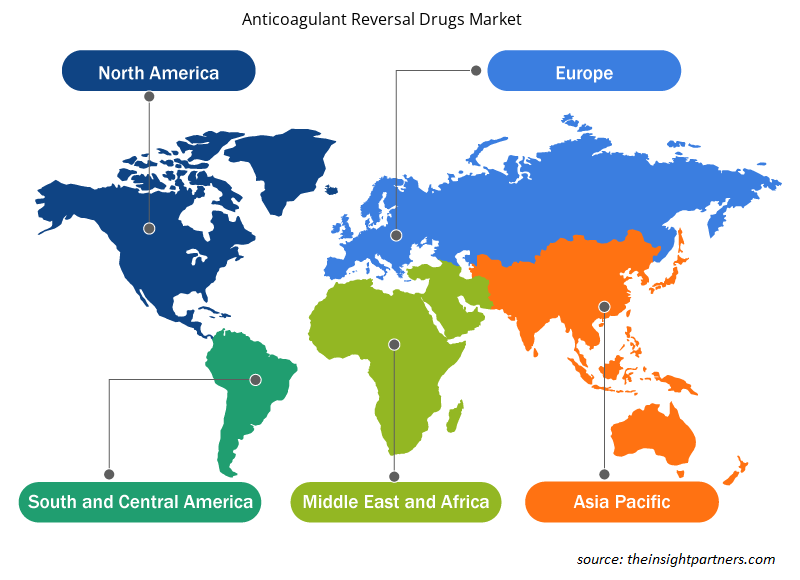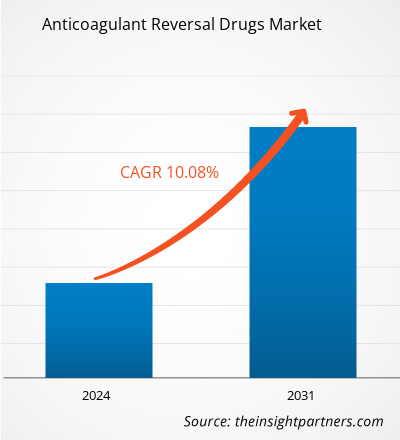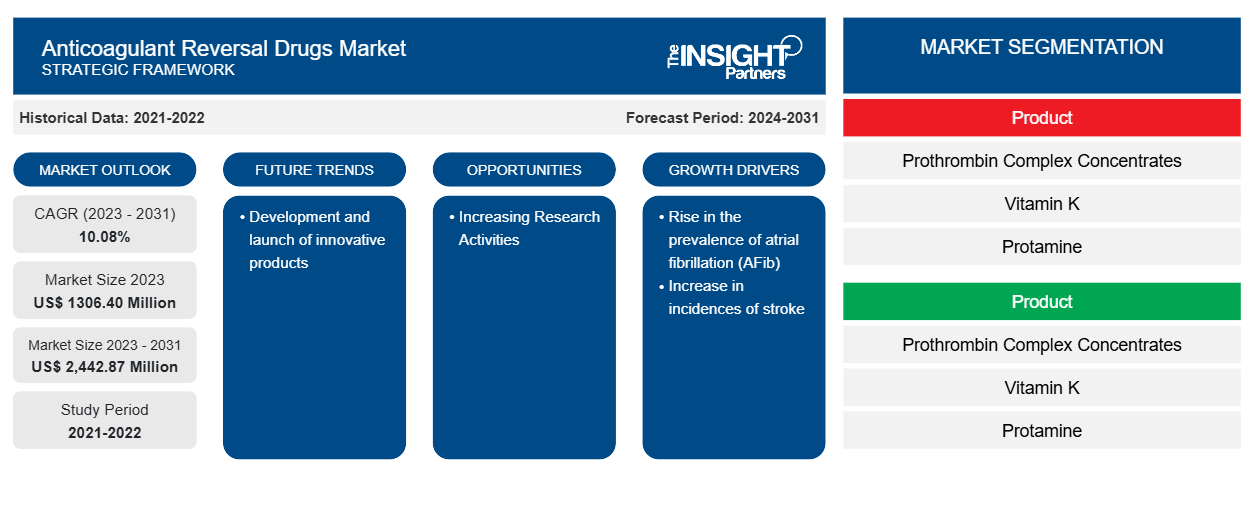Der Markt für Medikamente zur Umkehr der Blutgerinnung soll von 1.306,40 Millionen US-Dollar im Jahr 2023 auf 2.442,87 Millionen US-Dollar im Jahr 2031 anwachsen. Der Markt soll zwischen 2023 und 2031 eine durchschnittliche jährliche Wachstumsrate (CAGR) von 10,08 % verzeichnen. Die Entwicklung und Einführung innovativer Produkte dürften weiterhin wichtige Markttrends für Medikamente zur Umkehr der Blutgerinnung bleiben.
Marktanalyse für Medikamente zur Umkehrung der Blutgerinnung
In den letzten Jahren hat die Verwendung von Antikoagulanzien zur Vorbeugung und Behandlung verschiedener Herz-Kreislauf-Erkrankungen wie Lungenembolie (PE), tiefer Venenthrombose (DVT), Vorhofflimmern (AF), mechanischer Herzklappenthrombose und akuten Koronarsyndromen zugenommen. Die weit verbreitete Verwendung dieser Behandlungen birgt jedoch das Risiko größerer und kleinerer Blutungen, die zu Krankenhausaufenthalten und Besuchen in der Notaufnahme führen. Dieses Risiko kann sich erhöhen, wenn den Patienten eine Kombinationstherapie aus einem Antikoagulans und einem Thrombozytenaggregationshemmer oder eine duale Thrombozytenaggregationshemmung verschrieben wird. Bei alleiniger Anwendung bergen Warfarin und Aspirin das höchste Blutungsrisiko. Daher werden Medikamente zur Umkehrung der Blutung eingesetzt, um Blutungen vorzubeugen. Die zunehmende Prävalenz von Vorhofflimmern (AFib) und die Zunahme von Schlaganfällen dürften die Entwicklung neuer Behandlungen zur Verbesserung der Sprache begünstigen.
Marktübersicht für Medikamente zur Umkehrung der Blutgerinnung
Wie die Centers for Disease Control and Prevention (CDC) hervorheben, kommt es in den USA jedes Jahr zu mehr als 454.000 Krankenhauseinweisungen wegen Vorhofflimmern, die zu etwa 158.000 Todesfällen führen. Darüber hinaus steigt das Risiko, an Vorhofflimmern zu erkranken, mit dem Alter, und Bluthochdruck, der mit zunehmendem Alter ebenfalls häufiger auftritt, ist in etwa einem von fünf Fällen von Vorhofflimmern ein Faktor. Die wachsende geriatrische Bevölkerung wird voraussichtlich im kommenden Jahrzehnt zu einer steigenden Nachfrage nach Medikamenten zur Umkehrung der Blutgerinnung führen.
Passen Sie diesen Bericht Ihren Anforderungen an
Sie erhalten kostenlos individuelle Anpassungen an jedem Bericht, einschließlich Teilen dieses Berichts oder einer Analyse auf Länderebene, eines Excel-Datenpakets sowie tolle Angebote und Rabatte für Start-ups und Universitäten.
-
Holen Sie sich die wichtigsten Markttrends aus diesem Bericht.Dieses KOSTENLOSE Beispiel umfasst eine Datenanalyse von Markttrends bis hin zu Schätzungen und Prognosen.
Markttreiber und Chancen für Medikamente zur Umkehrung der Blutgerinnung
Zunehmende neurodegenerative Erkrankungen und Sprachstörungen begünstigen den Markt
Medikamente zur Umkehrung der Blutgerinnung werden bei der Behandlung von hämorrhagischen Schlaganfällen eingesetzt, um anhaltende Blutungen zu verringern und die Regeneration des Gewebes zu ermöglichen. In Ländern mit niedrigem und mittlerem Einkommen ist die Zahl der Schlaganfälle gestiegen . Laut der Stroke Awareness Foundation erleiden in den USA jedes Jahr etwa 795.000 Menschen einen Schlaganfall, was für über 140.000 Todesfälle pro Jahr verantwortlich ist. Davon sind etwa 40 % der schlaganfallbedingten Todesfälle Männer, während die restlichen 60 % Frauen betreffen. In einem im Mai 2021 in den Annals of Palliative Medicine (APM) veröffentlichten Artikel wurde einem Patienten unter Warfarin-Behandlung, der an einem akuten ischämischen Schlaganfall (AIS) litt, eine Kombination aus 4-Faktor-Prothrombinkomplex-Konzentrat, frisch gefrorenem Plasma und Vitamin K1 verabreicht. Der Bericht zeigte eine neurologische Verbesserung und eine erfolgreiche Umkehr der Gerinnung bei AIS-Patienten mit Warfarin-bedingter Hyperkoagulabilität. Daher ist die steigende Zahl an Schlaganfällen ein wesentlicher Treiber für den Marktanteil von Medikamenten zur Umkehrung der Blutgerinnung.APM) in May 2021, a combination of 4-factor prothrombin complex concentrate, fresh frozen plasma, and vitamin K1 was administered in a patient under warfarin treatment who suffered from acute ischemic stroke (AIS). The report showed neurological improvement and successful reversal of coagulation regarding AIS patients with warfarin-related hypercoagulability. Therefore, propelling incidences of stroke are a major driver of anticoagulant reversal drugs market share.
Zunehmende Forschungsaktivitäten – eine Chance für die Entwicklung neuer Medikamente zur Antikoagulanzienreduktion
Die rasch fortschreitenden Forschungsaktivitäten bei der Entwicklung neuartiger Therapeutika weltweit zur Bekämpfung der zunehmenden Verbreitung von Herz-Kreislauf-Erkrankungen wie Vorhofflimmern treiben das Wachstum des Marktes für Medikamente zur Umkehrung der Blutgerinnung voran. Es besteht immer Bedarf an innovativen Therapieansätzen bei der Behandlung verschiedener kardiovaskulärer Indikationen. So wurde beispielsweise die im Juli 2020 im Journal of Thrombosis and Haemostasis veröffentlichte Studie mit dem Titel „Evaluation of andexanet alfa and four‐factor prothrombin complex concentrate (4F‐PCC) for reversal of rivaroxaban‐ and apixaban‐associated intracranial hemorrhages“ am Massachusetts General Hospital durchgeführt, um die Wirksamkeit von Andexanet alfa bei der Behandlung von intrakraniellen Blutungen (ICH) zu untersuchen. Somit fördert die zunehmende Zahl der Forschungsaktivitäten die Aktivitäten zur Arzneimittelentdeckung und bietet lukrative Möglichkeiten für Marktwachstum in der gesamten Branche.andexanet alfa and four‐factor prothrombin complex concentrate (4F‐PCC) for reversal of rivaroxaban‐ and apixaban‐associated intracranial hemorrhages,’ published in July 2020 in the Journal of Thrombosis and Haemostasis, was conducted in Massachusetts General Hospital, to investigate the efficacy of andexanet alfa in the treatment of intracranial hemorrhages (ICH). Thus, the increasing number of research activities is boosting drug discovery activities and offering lucrative opportunities for market growth across the industry.
Marktbericht zu Medikamenten zur Umkehrung der Blutgerinnung – Segmentierungsanalyse
Wichtige Segmente, die zur Ableitung der Marktanalyse für Medikamente zur Umkehrung der Blutgerinnung beigetragen haben, sind Produkt und Vertriebskanal.
- Basierend auf dem Produkt ist der Markt für Medikamente zur Umkehrung der Blutgerinnung in Prothrombinkomplexkonzentrate, Vitamin K, Protamin, Tranexamsäure, Idarucizumab und AndeXXa unterteilt. Das Segment der Prothrombinkomplexkonzentrate hatte im Jahr 2023 den größten Marktanteil.
- In Bezug auf die Vertriebskanäle ist der Markt für Medikamente zur Antikoagulanzienumkehr in Krankenhausapotheken, Einzelhandelsapotheken und andere unterteilt. Das Segment der Krankenhausapotheken hatte im Jahr 2023 den größten Marktanteil.
Marktanteilsanalyse für Medikamente zur Umkehrung der Blutgerinnung nach geografischen Gesichtspunkten
Der geografische Umfang des Marktberichts zu Medikamenten zur Umkehrung der Blutgerinnung ist hauptsächlich in fünf Regionen unterteilt: Nordamerika, Asien-Pazifik, Europa, Naher Osten und Afrika sowie Süd- und Mittelamerika.
Nordamerika dominiert den Markt für Medikamente zur Umkehrung der Blutgerinnung. In Nordamerika sind die USA der größte Markt für Medikamente zur Umkehrung der Blutgerinnung. Das Wachstum dieses Marktes wird in erster Linie durch die zunehmende Verbreitung von Herz-Kreislauf-Erkrankungen wie Vorhofflimmern und Entwicklungen der Marktteilnehmer vorangetrieben. Die Präsenz wichtiger Marktteilnehmer in den USA wird das Wachstum dieses Marktes in diesem Land beschleunigen. Auch strategische Entwicklungen der Marktteilnehmer in den USA dürften das Wachstum des Marktes begünstigen. So hat AstraZeneca im Juni 2023 die vollständigen Zulassungsanträge für sein Andexxa (Andexanet alfa) in den USA und der EU eingereicht und damit die derzeitige bedingte Zulassung übertroffen. Andexxa ist ein Medikament, das die gerinnungshemmenden Wirkungen direkter oraler FXa-Hemmer schnell umkehren kann. Über 15 nationale und internationale Richtlinien aus mehreren Disziplinen unterstützen seine Anwendung. AstraZeneca hat nun die Zulassungsanträge für die vollständige Zulassung in den USA eingereicht.
Regionale Einblicke in den Markt für Medikamente zur Umkehrung der Blutgerinnung
Die regionalen Trends und Faktoren, die den Markt für Medikamente zur Umkehr der Blutgerinnung im Prognosezeitraum beeinflussen, wurden von den Analysten von Insight Partners ausführlich erläutert. In diesem Abschnitt werden auch die Marktsegmente und die Geografie von Medikamenten zur Umkehr der Blutgerinnung in Nordamerika, Europa, im asiatisch-pazifischen Raum, im Nahen Osten und Afrika sowie in Süd- und Mittelamerika erörtert.

- Erhalten Sie regionale Daten zum Markt für Medikamente zur Umkehrung der Blutgerinnung
Umfang des Marktberichts zu Medikamenten zur Umkehrung der Blutgerinnung
| Berichtsattribut | Details |
|---|---|
| Marktgröße im Jahr 2023 | 1306,40 Millionen US-Dollar |
| Marktgröße bis 2031 | 2.442,87 Millionen US-Dollar |
| Globale CAGR (2023 - 2031) | 10,08 % |
| Historische Daten | 2021-2022 |
| Prognosezeitraum | 2024–2031 |
| Abgedeckte Segmente |
Nach Produkt
|
| Abgedeckte Regionen und Länder |
Nordamerika
|
| Marktführer und wichtige Unternehmensprofile |
|
Marktteilnehmerdichte: Der Einfluss auf die Geschäftsdynamik
Der Markt für Medikamente zur Umkehrung der Blutgerinnung wächst rasant. Dies wird durch die steigende Nachfrage der Endverbraucher aufgrund von Faktoren wie sich entwickelnden Verbraucherpräferenzen, technologischen Fortschritten und einem größeren Bewusstsein für die Vorteile des Produkts vorangetrieben. Mit der steigenden Nachfrage erweitern Unternehmen ihr Angebot, entwickeln Innovationen, um die Bedürfnisse der Verbraucher zu erfüllen, und nutzen neue Trends, was das Marktwachstum weiter ankurbelt.
Die Marktteilnehmerdichte bezieht sich auf die Verteilung der Firmen oder Unternehmen, die in einem bestimmten Markt oder einer bestimmten Branche tätig sind. Sie gibt an, wie viele Wettbewerber (Marktteilnehmer) in einem bestimmten Marktraum im Verhältnis zu seiner Größe oder seinem gesamten Marktwert präsent sind.
Die wichtigsten auf dem Markt für Medikamente zur Umkehrung der Blutgerinnung tätigen Unternehmen sind:
- Sanofi,
- Johnson & Johnson,
- Glaxosmithkline,
- Bausch Health,
- Takeda Pharma
- Lexicon Pharmaceuticals, Inc.
Haftungsausschluss : Die oben aufgeführten Unternehmen sind nicht in einer bestimmten Reihenfolge aufgeführt.

- Überblick über die wichtigsten Akteure auf dem Markt für Medikamente zur Umkehrung der Blutgerinnung
Marktnachrichten und aktuelle Entwicklungen zu Medikamenten zur Umkehrung der Blutgerinnung
Der Markt für Medikamente zur Umkehrung der Blutgerinnung wird durch die Erhebung qualitativer und quantitativer Daten aus Primär- und Sekundärforschung bewertet, die wichtige Unternehmensveröffentlichungen, Verbandsdaten und Datenbanken umfasst. Im Folgenden finden Sie eine Liste der Entwicklungen auf dem Markt für Sprach- und Sprechstörungen sowie Strategien:
- AstraZeneca Pharma India Ltd. gab bekannt, dass es von der Central Drugs Standard Control Organisation (CDSCO) in Indien die Genehmigung zum Import und zur Vermarktung von Andexanet Alfa erhalten hat. Dieses Medikament ist wirksam bei der Behandlung lebensbedrohlicher oder refraktärer Blutungen, die mit der Verwendung von Faktor-Xa-(FXa)-Hemmern einhergehen. (Quelle: AstraZeneca Pharma, Pressemitteilung, 2024)
- Octapharma USA gab die Zulassung von Balfaxar durch die US-amerikanische Food and Drug Administration (FDA) bekannt. Balfaxar ist ein nicht aktiviertes Vier-Faktor-Prothrombinkomplex-Konzentrat (4F-PCC), das Vitamin-K-abhängige Faktoren enthält: Faktor II (Prothrombin), Faktor VII, Faktor IX und Faktor X sowie die antithrombotischen Proteine C und S. Es kann zur dringenden Behandlung eines erworbenen Gerinnungsfaktormangels eingesetzt werden, der durch eine Therapie mit Vitamin-K-Antagonisten (VKA) bei erwachsenen Patienten verursacht wurde, die dringend operiert werden müssen oder invasive Eingriffe benötigen. Balfaxar hilft bei der Wiederherstellung der Blutgerinnung, indem es den Gehalt an Gerinnungsfaktoren wieder auffüllt, die aufgrund einer Warfarin-Therapie fehlen. (Quelle: Octapharma USA, Inc, Pressemitteilung, 2023)
Marktbericht zu Medikamenten zur Umkehrung der Blutgerinnung – Umfang und Ergebnisse
Der Bericht „Marktgröße und Prognose für Medikamente zur Umkehrung der Blutgerinnung (2021–2031)“ bietet eine detaillierte Analyse des Marktes, die die folgenden Bereiche abdeckt:
- Marktgröße und Prognose auf globaler, regionaler und Länderebene für alle wichtigen Marktsegmente, die im Rahmen des Projekts abgedeckt sind
- Marktdynamik wie Treiber, Beschränkungen und wichtige Chancen
- Wichtige Zukunftstrends
- Detaillierte PEST/Porters Five Forces- und SWOT-Analyse
- Globale und regionale Marktanalyse mit wichtigen Markttrends, wichtigen Akteuren, Vorschriften und aktuellen Marktentwicklungen
- Branchenlandschaft und Wettbewerbsanalyse, einschließlich Marktkonzentration, Heatmap-Analyse, prominenten Akteuren und aktuellen Entwicklungen
- Detaillierte Firmenprofile
- Historische Analyse (2 Jahre), Basisjahr, Prognose (7 Jahre) mit CAGR
- PEST- und SWOT-Analyse
- Marktgröße Wert/Volumen – Global, Regional, Land
- Branchen- und Wettbewerbslandschaft
- Excel-Datensatz
Aktuelle Berichte
Verwandte Berichte
Erfahrungsberichte
Grund zum Kauf
- Fundierte Entscheidungsfindung
- Marktdynamik verstehen
- Wettbewerbsanalyse
- Kundeneinblicke
- Marktprognosen
- Risikominimierung
- Strategische Planung
- Investitionsbegründung
- Identifizierung neuer Märkte
- Verbesserung von Marketingstrategien
- Steigerung der Betriebseffizienz
- Anpassung an regulatorische Trends























 Kostenlose Probe anfordern für - Markt für Medikamente zur Umkehrung der Blutgerinnung
Kostenlose Probe anfordern für - Markt für Medikamente zur Umkehrung der Blutgerinnung